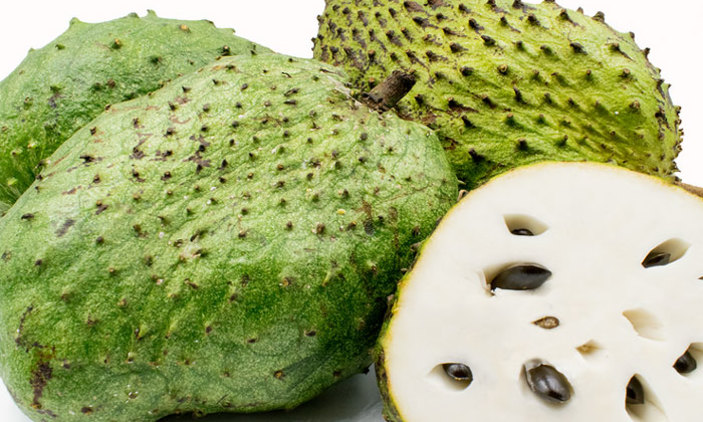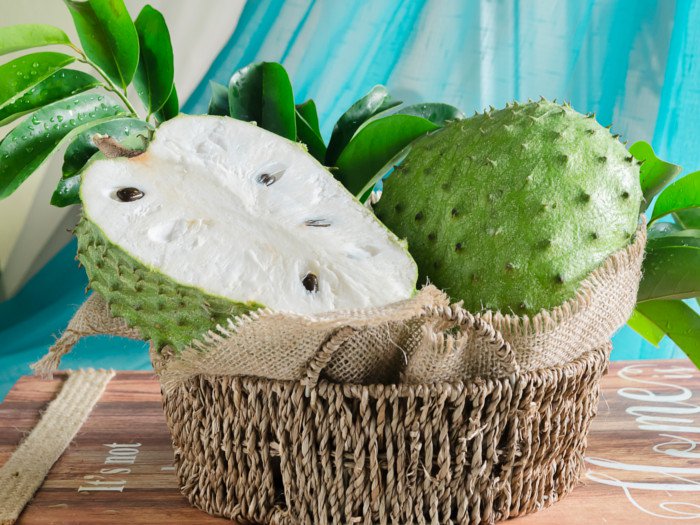If you’re feeling to eat something slightly creamy, juicy, tangy and refreshing then soursop is the right thing to satisfy that craving. Soursop is known to have the taste combination of strawberries and apples along with sour citrus flavor notes. This taste is contrasted with the underlying creamy texture reminiscent of coconut or banana with the aroma pleasantly similar to the smell of a pineapple.

Soursop | https://www.newvision.co.ug/new_vision/news/1465712/grow-soursop
Origin Of Soursop
Soursop is the fruit of Annona muricata, a broadleaf, flowering, evergreen tree. The exact origin is unknown; it is native to the tropical regions of the Americas and the Caribbean and is widely propagated. It is in the same genus, Annona, as cherimoya and is in the Annonaceae family.
Tip: Soursop is widely promoted as an alternative cancer treatment, but there is no medical evidence it is effective for treating cancer or any disease.
Scientific Classification Of Soursop
Soursop – Annona muricata [Scientific name]
- Kingdom: Plantae
- Clade: Angiosperms
- Clade: Magnoliids
- Order: Magnoliales
- Family: Annonaceae
- Genus: Annona
- Species: A. muricata
Benefits Of The Soursop
- May help fight cancer – According to one study, the soursop plant is a proven cancer remedy for most types of the disease. Though the tests haven’t been conducted on humans yet, the possibilities are promising. In another Indian study conducted on various cell lines, soursop leaves showed 80% cell inhibition. The acetogenins in soursop inhibit the harmful compounds in cancer cells.
- Filled with beneficial antioxidants that may help reduce eye disease – Antioxidants such as vitamins C and E, zinc, and beta-carotene, have been found to decrease the risk of eye disease. The antioxidants also reduce oxidative stress, which can otherwise cause cataracts and age-related macular degeneration.
- Exhibits anti-inflammatory and antimicrobial properties – In a Brazilian study, inflammation caused by snakebite was found to improve with the administration of soursop leave and juice.
- Potentially kills pancreatic cancer cells – A study conducted by the University of Nebraska Medical Center found that the extract can greatly reduce pancreatic cancer.
- Treats infections – Soursop can treat infections caused by bacteria and parasites, one of those being leishmaniasis, a disease caused by parasites that are transmitted through the bites of sand fleas. The leaves of the soursop tree are also used to treat a wide range of infections.
- Aids diabetic treatments – The soursop leaf aqueous extract was found to inhibit (and even prevent) the hepatic oxidative damage caused in diabetes patients.
- Kidney and liver health boost – According to an Indian study, the acetogenins in soursop can kill the malignant cells of 12 types of cancer, with liver cancer being one of them.
- Respiratory health improvement – One Nigerian study states the efficacy of soursop leaves in treating respiratory conditions like asthma.
- Relieves stress – As per a report by the University of Connecticut, soursop can be used extensively for the treatment of stress and other issues like depression.
- Enhances gastrointestinal health – The significant antioxidant and anti-inflammatory properties of the fruit can help improve gastrointestinal health.
- Boosts the immune system – The juice of the soursop fruit was found to provide more micronutrients than its pulp. But the pulp has more amount of vitamin A than the juice. Soursop is also rich in ascorbic acid (vitamin C) that strengthens and boosts the immune system. Beta-carotene, the precursor of vitamin A, also contributes to an enhanced immune system.
- Improves skin– As per a report published in the U.S. National Library of Medicine, the extract of soursop leaves can help prevent skin papilloma, a disease that causes tumor eruptions on the skin.
Nutritional Facts Of Soursop
Soursop contains significant amounts of vitamin C, vitamin B1 and vitamin B2. The compound annonacin, which is contained in the seeds of soursop, is a neurotoxin identified in preliminary research.
A 100-gram serving of raw soursop contains about:
- 66 calories
- 16.8 grams carbohydrates
- 1 gram protein
- 0.3 gram fat
- 3.3 grams fiber
- 20.6 milligrams vitamin C (34 percent DV)
- 278 milligrams potassium (8 percent DV)
- milligram thiamine (5 percent DV)
- 21 milligrams magnesium (5 percent DV)
- 0.9 milligram niacin (4 percent DV)
- milligram copper (4 percent DV)
- milligram riboflavin (3 percent DV)
- milligram vitamin B6 (3 percent DV)
- 14 micrograms folate (3 percent DV)
- 0.6 milligram iron (3 percent DV)
- 27 milligrams phosphorus (3 percent DV)
- milligram pantothenic acid (3 percent DV)
How To Eat Soursop
The soursop’s green leathery skin is covered in small thorns but it is surprisingly tender. Despite its somewhat severe appearance, with a few well-placed cuts, soursop can be peeled with little effort. The pulp is fibrous, milky white and contains distinctive black seeds, while the skin is bitter. Soursop can be eaten with a spoon, but it is often used as a blended ingredient. You can extract soursop juice by pressing the deseeded pulp through a sieve, colander or cheesecloth.
Did You Know? It is a good reminder to remove the mildly toxic seeds before eating the soursop fruit.
Soursop and Cinnamon Milkshake
Ingredients:
- 1 ripe soursop
- 1/2 cup coconut water
- ½ cup almond milk
- 1 medium frozen banana
- 1/8 teaspoon nutmeg
- ⅛ teaspoon cinnamon
- 1 teaspoon vanilla flavoring
Method:
- In a blender, place the soursop, coconut water and almond milk. Blend until smooth.
- Then add the remaining ingredients and blend until smooth.
- For a thicker shake, use less liquid ingredients. For a thinner shake, add more almond milk.
- Once you have the shake at your desired consistency, pour into a glass and sprinkle the top with cinnamon.
- Add a cinnamon stick for a nice touch.
Chilled Soursop Drink
Ingredients:
- 1 soursop fruit, peeled, cut into chunks
- 2 tablespoons of sugar
- 1 1/2 cups of milk
- 1/2 teaspoon of ground cinnamon
- 2 teaspoons of vanilla extract
- 1/4 teaspoon of ground nutmeg
Method:
- Work in batches. Press the soursop chunks against a fine mesh strainer using the back of a spoon or a ladle. Let the juice fall into a bowl.
- Add the other ingredients to the bowl and whisk thoroughly. Pour the drink into a pitcher and refrigerate it.
Soursop Smoothie
Ingredients:
- 1 cup soursop fruit, peeled and cut into chunks
- 1 1/2 cups of coconut milk, or to taste
- 1/2 teaspoon ground cinnamon
- 2 teaspoons of vanilla extract
- 1/4 teaspoon of ground nutmeg
- 2 tablespoons of monk fruit sweetener, to taste
Method:
- Press soursop pieces through a colander or strainer with a spoon to extract the juice into bowl.
- Whisk coconut milk, monk fruit, vanilla, cinnamon and nutmeg into soursop juice until sweetener dissolves completely. Pour into a pitcher and refrigerate until chilled.
Soursop In Guyana
According to one chronicle newspapers, “There are many different varieties of soursop trees in Guyana. There are three well known varieties: Blanca, Lizza and Marado. The National Agricultural Research and Extension institute (NAREI) is currently conducting studies to develop prescriptions to classify the lesser known varieties, based on various configurations such as taste and shape; and rectify the nutrient deficiencies observed in the fruit.” This amazing fruit is bountifully grown in Guyana, some farmers produce it by bulk to sell to consumers, some people grow it in their backyard, and some sell it at the corner of the streets and in the market. It is a beneficial fruit in Guyana; many cherish it for its properties to kill cancer. Some just love the refreshing taste of it, whether they eat it just as it is, drink it as a drink, milkshake or even a smoothie.
Watch This: How to eat soursop
Article References:
- http://guyanachronicle.com/2017/06/11/the-effects-and-management-of-the-soursop-wasp
- https://en.wikipedia.org/wiki/Soursop
- https://foodfacts.mercola.com/soursop.html
- https://draxe.com/soursop/
- https://www.stylecraze.com/articles/benefits-of-soursop-for-skin-hair-and-health/







